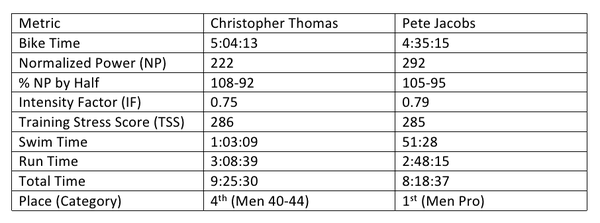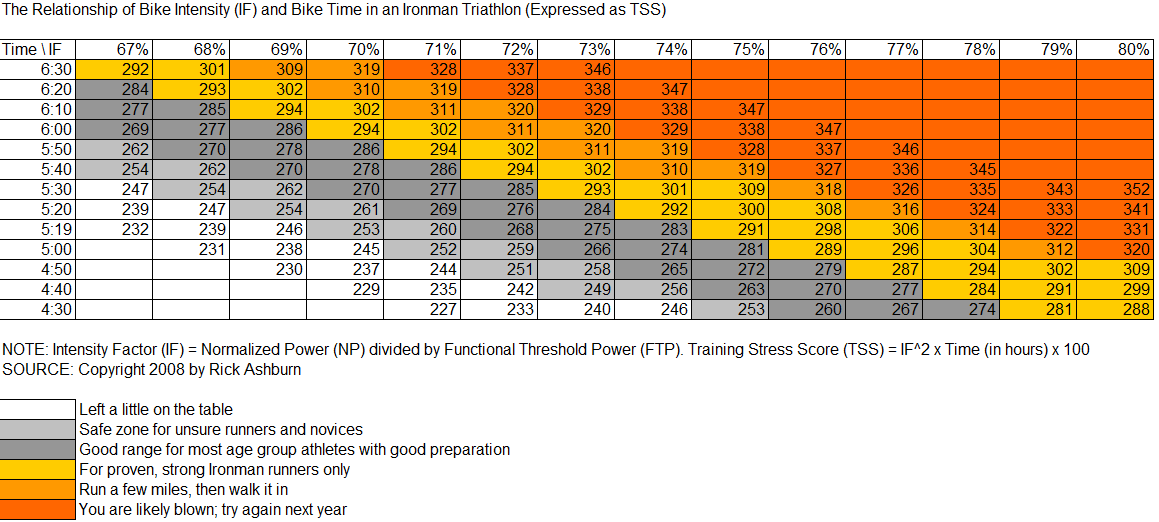Using a power meter in an Ironman triathlon is almost like cheating. While others are trying to gauge intensity through a cloudy veil of emotion, which makes perceived exertion and even heart rate nearly useless, the athlete with a power meter is focused on a number that, if maintained with only slight variations, will produce an optimal bike split.
Note that I said “optimal.” The goal on the bike is not to produce the fastest time possible, but rather the time that will leave the athlete with enough spring in the legs to actually run the marathon. A maximally fast bike time means a 26.2 mile walk. Such a marathon always leads the dejected athlete to believe he or she is simply a poor runner. That’s seldom the case. It is usually a bike-related issue.
Why Power is Important
A power meter prevents this from happening if used correctly. It provides several real-time measures of progress throughout the race. Two that are critical to the Ironman triathlete are Training Stress Score® (TSS®) and Intensity Factor® (IF®). Determining what these should be weeks in advance of race day and then training with these numbers allows the athlete to ride at an intensity that will produce an optimal split and a best- possible Ironman run time.
If you already have a power meter you are probably aware of TSS and IF. Few athletes, however, really understand their value in a long, steady-state bike race such as an Ironman. So let’s do a quick refresher using a couple of recent Ironman Hawaii examples and then I’ll show you how to use these numbers to produce a fast Ironman.
TSS and IF came from the mind of Dr. Andy Coggan, a highly regarded exercise physiologist and roadie. He has singlehandedly created a system for effectively measuring and using power data. What is described here comes from his genius.
What are TSS and IF?
You don’t need to understand all of the details of these terms, but for those who may be interested, here are the ways TrainingPeaks and WKO5 software determine each after a ride. During the race or workout the head unit on your handlebars is doing the same calculations and displaying the numbers in real time. Bear with me for a short time while I explain them. We’ll start with the formulae and then I’ll explain.
Training Stress Score is a way of using a number to tell how hard a ride was. It’s based on the interplay of intensity (power) and duration (time). The formula is…
TSS = IF2 x bike time (in hours) x 100
That then brings us to Intensity Factor. Here’s the formula. Again, this is not on the test, but it’s important for where I’m taking you with this discussion—to a faster run off the bike.
IF = Normalized Power (NP) ÷ Functional Threshold Power (FTP)
Don’t worry too much about “Normalized Power.” It’s just a number your power meter and the software compute which is similar to average power but with an emphasis on the metabolically costly surges you made throughout the race. What you must understand is the other part of the formula: Functional Threshold Power (FTP).
FTP is not calculated by the power meter or the software. They accept whatever you tell them your personal FTP is. It’s simply a number that lets you know what the greatest average power is that you can do for an hour. It generally takes a test or race to get this number right. This is the most critical component of using a power meter for a fast race.
Comparison: Pete Jacobs vs. Age Grouper
OK, now that you have a better understanding of what the numbers on your handlebars mean, let’s take a look at two athletes—a pro and an age grouper—from this year’s race in Kona to get a sense of what it all means.
Here are the basic power metrics for Pete Jacobs who won the Men’s Pro category and for Christopher Thomas of the Timex Multisport Team who finished fourth in the Men’s 40-44. (We thank both athletes for being gracious enough to share their data; Jacobs’ was collected through his Quarq power meter and Thomas’ was collected through his Timex devices).

Note that their TSS were almost the same—286 for Chris and 285 for Pete. So why was Pete 29 minutes faster if their TSS were essentially the same? Because his FTP is higher. Pete’s is 370 watts and Chris’ is 296. The higher your FTP, the faster you can ride.
Pete’s Quarq power meter showed that he rode at an IF of 0.79. That means his Normalized Power was 292 which is 79% of 370. The men’s pro winner in an Ironman almost always finishes the ride with an IF of about 80%. You can count on it.
Chris’ IF was 0.75 so he rode at an average of 75% of his 296 FTP. That produced a bike split of 5:04:13—very respectable for the heat, humidity, and hills of Kailua Kona.
I’d like to point out, however, that Chris probably could have improved his run time (a not-too-shabby 3:08:39) a little by pacing his bike a bit more evenly. Note that in the “% NP by Half” metric that he rode at a much higher power output for the first 56 miles (108%) than he did for the last 56 miles (92%). This is partly explained by the greater amount of hill climbing in the first half of the course. But note that Pete, on obviously the very same course, parsed it out with a slightly more balanced power distribution (105-95%). The pro race strategy must be significantly different from that of the age groupers—an interesting topic for another time. Chris’ strategy would have resulted in less fatigue by the start of the run had he done something like 103-97%. That would have produced the same NP but would have better reflected the nature of the course while conserving energy.
I’m certainly not trying to be critical of Chris here. Finishing 4th in your age group at the Ironman World Championship is quite an accomplishment and his finish time of 9:25:30 is outstanding. What he definitely got right was the overall Intensity Factor and Training Stress Score. Had he gotten these too high or too low it would have resulted in a far slower finishing time. He could just tweak his pacing a small amount to make the bike split even faster.
Here’s a table I use to help determine what an athlete’s IF and TSS should be for an Ironman race. This was created by Rick Ashburn. If you know how to use it you can nail your Ironman bike and come off with good legs for running.

How to Use the Table
Your bike-finish TSS should fall into either the light gray, dark gray, or yellow sections depending on how you categorize yourself (see the color-code legend to find your race category). Then on the left side of the table find your goal bike time. By looking to the right of the goal time and in your color-coded category you’ll see a range of one to four TSS numbers. Then by glancing up to the top row for both ends of this colored range you’ll see what your IF should be throughout the race. Then you simply ride in that IF range on race day and—voila!—you have your optimal bike time and are ready to actually run the marathon.
So let’s look at an example. My goal is to have a six-hour bike split in my next Ironman given my experience, the nature of the course and anticipated race-day weather conditions. I categorize myself as an “age group athlete with good preparation” (dark grey). By looking to the right from 6:00 I can see the anticipated TSS must be in the range of 269 to 286. Then looking up I can see that the IF range must be 67 to 69%. That means I’m going to ride at 67 to 69% of my FTP. So if my FTP on race is expected to be 250 watts (note that FTP rises as your fitness changes so it must be tested every four weeks or so), then my power range on race day must be 168 to 173 watts. I’ll go about 20% higher on the steepest hills (200 watts), and I’ll coast the steepest downhills (0 watts). By setting my head unit to show both instantaneous power and IF I can monitor and gauge my intensity throughout the bike leg of the race. And, of course, I will do workouts in which I practice doing the same, exact numbers. So on race day there will be nothing new. I just do what I’ve rehearsed dozens of times in training. And have a great race!
Are you new to training and racing with power? Joe Friel’s book The Power Meter Handbook offers triathletes and cyclists a simple user’s guide to using a power meter for big performance gains. Learn more here.

